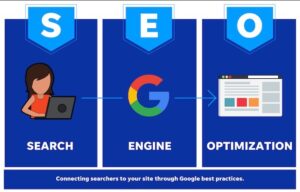SEO stands for “search engine optimization.” In simple terms, SEO means the process of improving your website to increase its visibility in Google, Microsoft Bing, and other search engines whenever people search for:
- Products you sell.
- Services you provide.
- Information on topics in which you have deep expertise and/or experience.
The better visibility your pages have in search results, the more likely you are to be found and clicked on. Ultimately, the goal of search engine optimization is to help attract website visitors who will become customers, clients or an audience that keeps coming back.
How is SEO different from SEM and PPC?
SEM and PPC are two other common terms you will read about a lot here on Search Engine Land and hear about in the larger search marketing community.
Read on to learn more about both of these terms and how they’re related to SEO.
SEO vs. SEM
SEM stands for search engine marketing – or, as it is more commonly known, search marketing.
Search marketing is a type of digital marketing. It is an umbrella term for the combination of SEO and PPC activities meant to drive traffic via organic search and paid search.
Put simply, search marketing is the process of gaining traffic and visibility from search engines through both paid and unpaid efforts.
So how do SEO and SEM differ? Technically they aren’t different – SEO is simply one-half of SEM:
- SEO = driving organic traffic from search engines.
- SEM = driving organic and paid traffic from search engines.
Now, this is where things get a bit confusing.
Today, many people use SEM interchangeably with PPC (which we’ll talk about in the next section).
This idea seems to undercut SEO. However, SEO is marketing, just like PPC is marketing.
Here’s the best way to think about SEO and SEM:
Imagine SEM is a coin. SEO is one side of that coin. PPC is on the flip side.
SEO vs. PPC

PPC stands for pay-per-click – a type of digital marketing where advertisers are charged whenever one of their ads gets clicked on.
Basically, advertisers bid on specific keywords or phrases that they want their ads to appear for in the search engine results. When a user searches for one of those keywords or phrases, the advertiser’s ad will appear among the top results.
So again, if we think of search marketing as a coin, SEO and PPC are two sides of the same coin – SEO is the unpaid side, PPC is the paid side.
Another key point: it’s important never to think of it as “SEO vs. PPC” (i.e., which one is better) because these are complementary channels. It’s not an either-or question – always choose both (as long as your budget allows it).
As we mentioned before, the terms SEM and PPC are used within the industry interchangeably. However, that isn’t the case here on Search Engine Land.
Whenever we mention “SEM,” it will be because we’re referring to both SEO (organic search) and PPC (paid search).
If you’re curious about the history behind how “SEM” came to mean “PPC” at the exclusion of SEO, you can dig deeper into these articles:
Why is SEO important?

SEO is a critical marketing channel. First, and foremost: organic search delivers 53% of all website traffic.
That’s one big reason why the global SEO industry is forecast to reach a staggering $122.11 billion by 2028. SEO drives real business results for brands, businesses and organizations of all sizes.
Whenever people want to go somewhere, do something, find information, research or buy a product/service – their journey typically begins with a search.
But today, search is incredibly fragmented. Users may search on traditional web search engines (e.g., Google, Microsoft Bing), social platforms (e.g., YouTube, TikTok) or retailer websites (e.g., Amazon).
In fact, 61% of U.S. online shoppers start their product search on Amazon, compared to 49% who start on a search engine like Google. Also of note from that same research:
- 32% start on Walmart.com.
- 20% start on YouTube.
- 19% start on Facebook.
- 15% start on Instagram.
- 11% start on TikTok.
Trillions of searches are conducted every year. Search is often the primary source of traffic for websites, which makes it essential to be “search engine friendly” on any platform where people can search for your brand or business.
What this all means is that improving your visibility, and ranking higher in search results than your competition, can positively impact your bottom line,
SEO is also incredibly important because the search engine results pages (or SERPs) are super competitive – filled with search features (and PPC ads). SERP features include:
- Knowledge panels.
- Featured snippets.
- Maps.
- Images.
- Videos.
- Top stories (news).
- People Also Ask.
- Carousels.
Another reason SEO is critical for brands and businesses: unlike other marketing channels, good SEO work is sustainable. When a paid campaign ends, so does the traffic. Traffic from social media traffic is at best unreliable – and a fraction of what it once was.
SEO is the foundation of holistic marketing, where everything your company does matters. Once you understand what your users want, you can then implement that knowledge across your:
- Campaigns (paid and organic).
- Website content.
- Social media properties.
SEO is a channel that drives the traffic you need to achieve key business goals (e.g., conversions, visits, sales). It also builds trust – a website that ranks well is generally regarded as authoritative or trustworthy, which are key elements Google wants to reward with better rankings.
